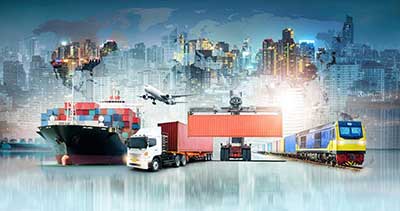Date: 03/12/2022
Relevance: GS-3: Infrastructure: Energy, Ports, Roads, Airports, Railways, etc.
Key Phrases: Global Supply Chain Dynamics, Geopolitical Shocks Of The Ukrainian Crisis, Multinational Enterprise-Specific Supply Chain, Sector Specific Supply Chain, Resilient Logistics Continuum, National Logistics Policy, PM Gatishakti National Master Plan.
Context:
- The global supply chain dynamics was severely disrupted in the last two years of the pandemic and recently by the geopolitical shocks of the Ukrainian crisis.
- Thus, there is an urgent need to make global supply chains more resilient to endure another ‘black swan’ event like the Covid-19 pandemic.
Key Highlights:
- The rise of MSMEs and start-ups has added a new dimension to the multinational enterprise-specific supply chain which is now a sector-specific supply chain.
- In India many MSMEs and start-ups source from across the country but the lack of modal mixes of transportation became a significant issue when the pandemic hit.
- The traditional reliance on road transportation proved costly when drivers were unavailable, leaving imports in gateway docks with no other modes of connected transportation.
Why is it imperative to diversify the supply chains across countries and companies?
- Inflation in food and medicine has sparked unrest and tensions the world over.
- Ideas over identifying affordable, resilient, and sustainable supply chains started being discussed in regional forums such as the QUAD, G10, and even multilateral forums such as UNCTAD as soon as the pandemic began to recede.
- The resilience of supply chains was stressed during the pandemic as they were on the verge of collapse.
- Although, though there is a softening of prices and a relative redundancy in the logistics component of the supply chain today, there is still a worry among the shipping lines for sustaining operations and resilience in the logistics domain in the long term.
Need for a resilient Logistics continuum:
- Resilience is necessary for the logistics sector to supplement the global supply, especially when the world is just coming out of the pandemic’s impact.
- Now, there is a need to think about various strategies to bring about resilience in GSC, GVC, and the logistics continuum.
The National Logistics Policy (NLP):
- Known as the Comprehensive Logistics Action Plan, the National Logistics Policy is an agenda to transform India’s logistics landscape by 2024.
- The policy comes at a time when the country is already witnessing major
changes in infrastructure planning such as-
- PM GatiShakti National Master Plan (NMP): By adopting a ‘whole of the government approach’ more than 1,400 connectivity projects have been planned which include 2,00,000 km of National Highways, more than 65 ports, three National Waterways, over 100 airports, and helipads and increasing the capacity of the rail network in the next few years.
- The National Logistics Policy adopts a similar approach and the proposals include efficiency drivers such as digitisation for enhancing human resource development.
- The policy dedicates specific chapters to creating an efficient EXIM Logistics landscape.
- It focuses on the need to build hinterland logistics infrastructure, strategic trade corridors, creating a pool of knowledgeable and skilled experts, and promote the use of new-age technologies for creating greater efficiency.
Relevance of growing complementarity of NMP and NLP:
- The NMP-NLP complementarity will provide a greater boost to the ongoing
initiatives of the government.
- For instance, the government’s One District, One Product (ODOP) and District as Export Hubs (DEH) schemes have been a significant effort towards building regional value chains across districts and their primary focus has been on identifying, branding, and promoting products from each district for exporters through district-level management and production.
- While the PM GatiShakti NMP can provide the infrastructure for these districts, the NLP can help the exporters from the district in developing their regional supply chains.
- The introduction of new age technologies such as AI, Blockchain, Machine Learning, along with creation of a pool of skilled and knowledgeable workforce through the policy will enhance resilience.
- PM GatiShakti and the National Logistics Policy together have the potential to not only bring resilience to the global supply chain dynamics that India can be connected to but also make the supply chain more standardised, predictable, and cost-efficient.
- The combination will enable synergies between human resource and technology and increase the efficiency of logistics.
- Such a complementarity between the two will also de-risk global investments in setting up manufacturing bases within the country thus helping India leverage the China+ 1 strategy.
Do you know?
China+ 1 strategy:
- China-plus-one is a strategy in which companies avoid investing only in China and diversify their businesses to alternative destinations.
- China was an attractive investment location due to the low cost of labour and production and an increasing domestic consumer market.
- Companies have started to think of alternative locations to invest because of the supply chain disruptions during the past year caused by the pandemic and China’s zero-Covid policy.
- This was fueled by an associated container shortage thus causing uncertainty and disrupting the supply of materials.
- Additionally, China brought out a data privacy law that specified how they collect and store data. This caused foreign technology companies to downsize their presence in China’s mainland.
Conclusion:
- As India takes over the presidency of G20, opportunities open up for India to lead by example in bringing about the desired resilience through transformative policy interventions and state-of-the-art technology.
- India is at an advantage since MNCs started investing in emerging countries and it is a viable option because of its low production cost and favorable business environment.
Source: Hindu BL
Mains Question:
Q. Discuss the need for a resilient global supply chain as well as various government efforts taken towards this direction. (150 words)








